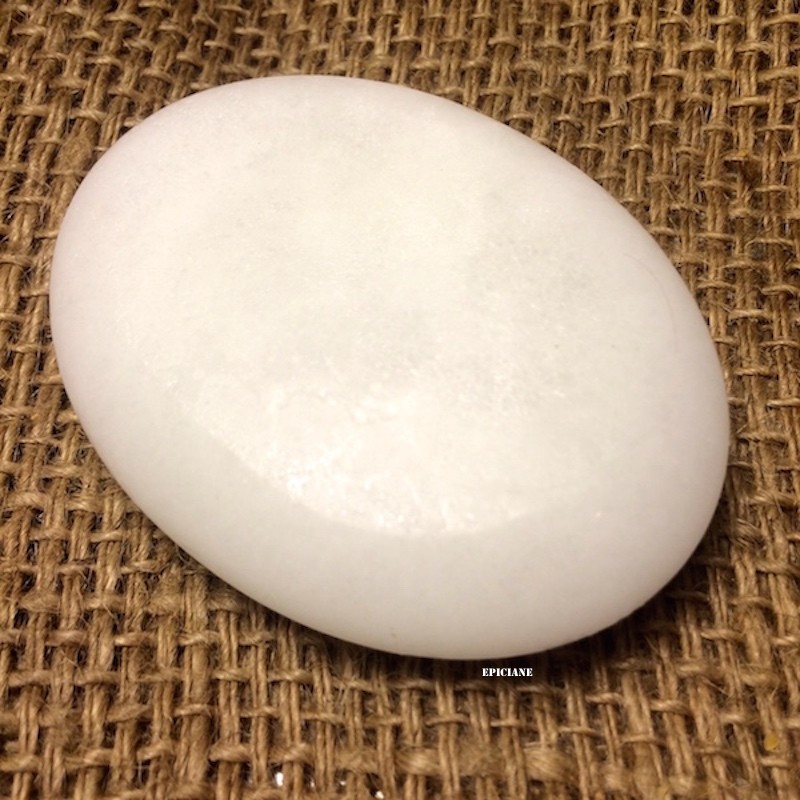


Two stones of approximately 155g each made from 100% NATURAL alum.
This mineral is an exceptional body deodorant, completely safe for your health!
 Delivery
Delivery
Mondial Relay
 Returns
Returns
See conditions
 Payments
Payments
100% secure
Who am I?
The stones offered here are made from NATURAL alum. Their oval shape allows for a comfortable grip and perfect comfort for the skin.
Alum stone is a mineral that naturally occurs in various regions of the world, especially in Syria. When it is natural, like the one offered here, it is composed of "potassium alum." This detail is important, as natural alum is considered completely safe for health, unlike artificial alum, whose chemical composition differs. Oncologists even recommend the use of natural alum as a deodorant instead of traditional deodorants for their patients.
How to use me?
No matter the reason for using it, always wet the alum stone and apply it to the skin while it's damp. Water slightly dissolves the mineral, leaving an invisible film on the skin. Do not rinse the skin afterward (as the film would wash away), and do not wipe it either—just let it air dry. Then store the stone in a dry place to prevent it from continuing to dissolve on its own.
However, be careful not to drop your stone, as it might not survive the fall!
My Qualities:
This mineral has multiple virtues and a wide range of uses.
A natural antiseptic, alum stone fights the bacteria responsible for unpleasant body odor. It is incredibly effective, lasting for over 12 hours! Moreover, it leaves no marks on clothing, even on black garments.
It is odorless, allowing you to enjoy your chosen fragrance—or none at all—without interference.
If you handle garlic or fish, rub your wet hands on the alum stone without rinsing afterward—the unpleasant odor will vanish instantly.
Alum stone is also astringent due to its acidic nature, tightening pores and regulating perspiration without blocking it. Its uses in this area are numerous:
Do you suffer from perpetually sweaty hands, making handshakes awkward? Carry a small stone in your pocket, and after each handwash, rub it in your damp hands like soap. Your hands will no longer be clammy!
Attending a dance party, and you don’t want your makeup to melt from sweat? Wet the stone and apply it to your face (avoiding the eyes) before putting on makeup, and you won't have that problem anymore. The alum stone tightens the pores, reducing sweat and preventing makeup from running.
Its astringent and antibacterial properties also help fight acne and cold sores, significantly reducing their duration as the alum stone dries them out with its antibacterial power. Simply wet the stone, apply it to the affected areas, and let the skin air dry.
Barbers and well-groomed men have used its astringent and hemostatic qualities for centuries by applying the wet stone after shaving to soften the skin, soothe razor burn, and stop the bleeding from minor cuts. The alum stone leaves skin healthy and free of redness.
Sewers also frequently use it to stop blood droplets when pricked by a needle, preventing stains on the fabric they are working on.
Alum is also used for many other purposes: in certain stages of fine leather tanning, in mordanting wool and fabric before dyeing, as a flocculant for water treatment in some of the world's poorest regions, as a laundry whitener (in powdered form), and even to turn hydrangeas blue when diluted in watering cans!
A Little History:
Ancient Rome was already aware of the benefits of alum stone.
At the end of the 15th century, significant alum deposits were discovered in Italy, in a region belonging to the Papal States. This discovery proved to be quite profitable for the pope, as alum was widely used in the textile industry at the time.
In North Africa, where it is found in abundance, it has been used since ancient times. Even today, it is believed to have magical properties, including the ability to remove the "evil eye" from young children. If a child falls ill without explanation, the stone is sometimes used in a specific manner to lift the "curse."
Reference: paprikafumé
Reference: Selpoivre5baies
Reference: pellebuisG8
Reference: Raclette
Reference: 00036306-0001
Reference: Box_découverte
Reference: Harissa
Reference: selpomme
Reference: 10M6810601
Reference: Rapemuscade
Reference: pellebuis6
Reference: selpetale
Reference: Selalgues

Two stones of approximately 155g each made from 100% NATURAL alum.
This mineral is an exceptional body deodorant, completely safe for your health!